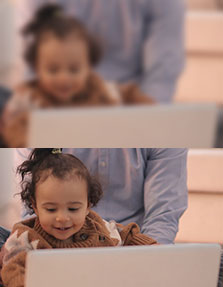Children and screens: what is the learning potential of these resources?

In the framework of the App2five international research, the team from the FLACSO Education and New Technologies Project (PENT) presented their bibliographic report on interaction and learning with mobile devices before the age of six. This theoretical systematization will allow conceptual and methodological decisions to be made to move forward with this project that seeks to build knowledge to design digital applications aimed at early childhood.
What studies exist on learning with technologies in children under six years of age? What does it consist on? How were they methodologically designed? Is there a proven relationship between interaction with technology and learning in children under six? Is it possible to recreate them? Based on these guiding questions, academic databases were reviewed and a bibliographic corpus of 86 scientific articles was assembled .
According to the report's conclusions, the interaction of minors with machines has specific characteristics, and is usually framed and modified by adult accompaniment .
The literature explored seems to agree that some children under the age of six do indeed learn with technology, although there are marked differences between one age and another, as well as between one infant and another. There are also different variables that affect learning with technology at early ages, such as the type of content and the way it is presented .
App2five is an international project coordinated by Dr. Lucrezia Crescenzi Lanna, from the Balmes de Vic University Foundation, and Dr. Mariona Grané Oró, from the University of Barcelona. The research is carried out thanks to the work of an interdisciplinary team of professionals from various Spanish institutions such as the University of VIC, University of Oviedo, University of Barcelona, Foundation of the University of Oberta, University of Malaga; and from Latin America such as the Education and New Technologies Project of the Latin American Faculty of Social Sciences (Argentina) and the Federal University of Santa Catarina (Brazil).
The PENT report, along with two others produced by other members of the international team, will serve as the basis for the next stage of the study. The bibliography surveyed will allow selecting the digital applications to be used during the field work, defining elements, observation procedures and analysis systems.






